ERTC
decentralized electronic payment system and new opportunities in the cryptocurrency world
Blocks Blockchain Size
ERTC Token Emission
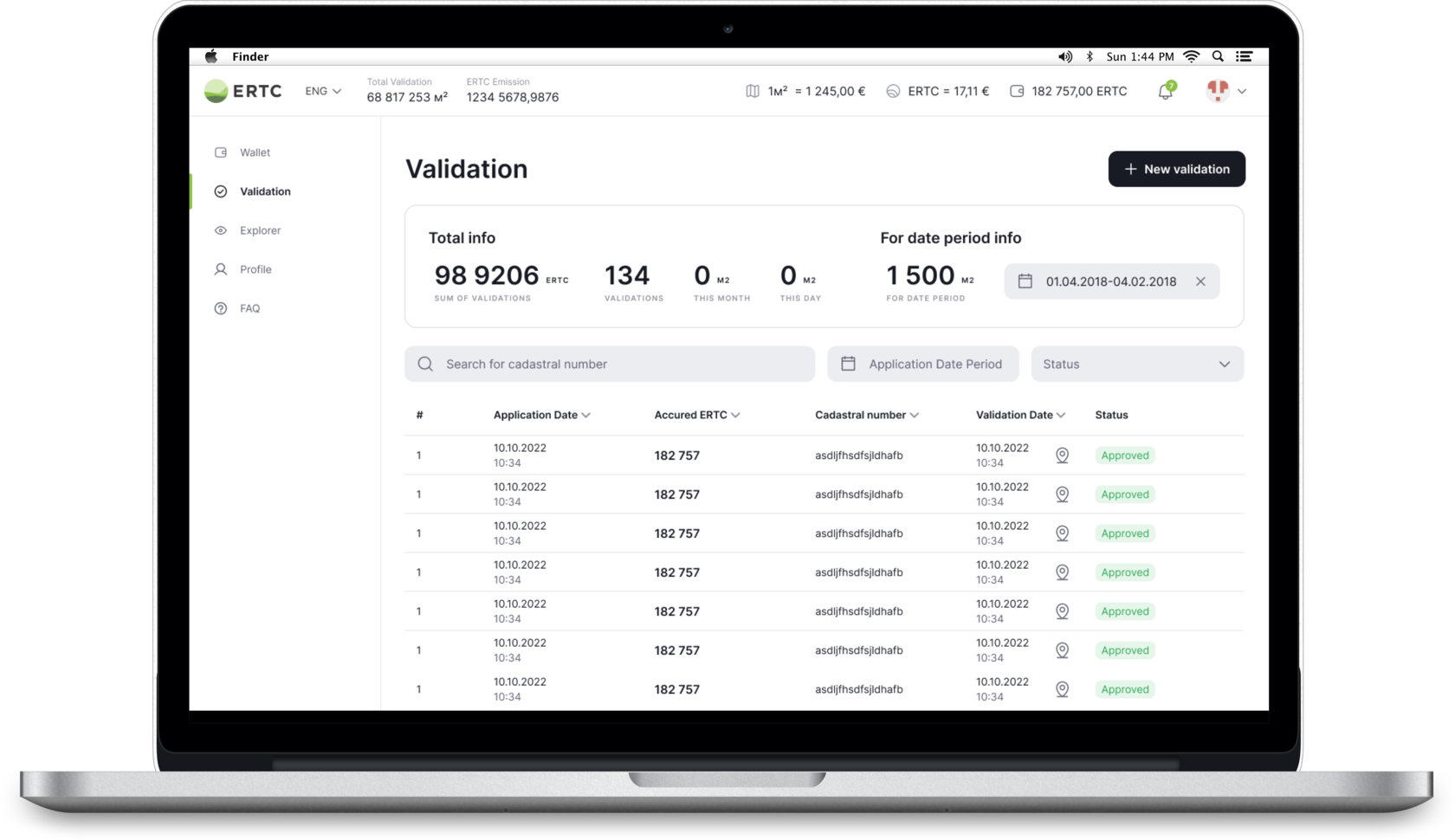
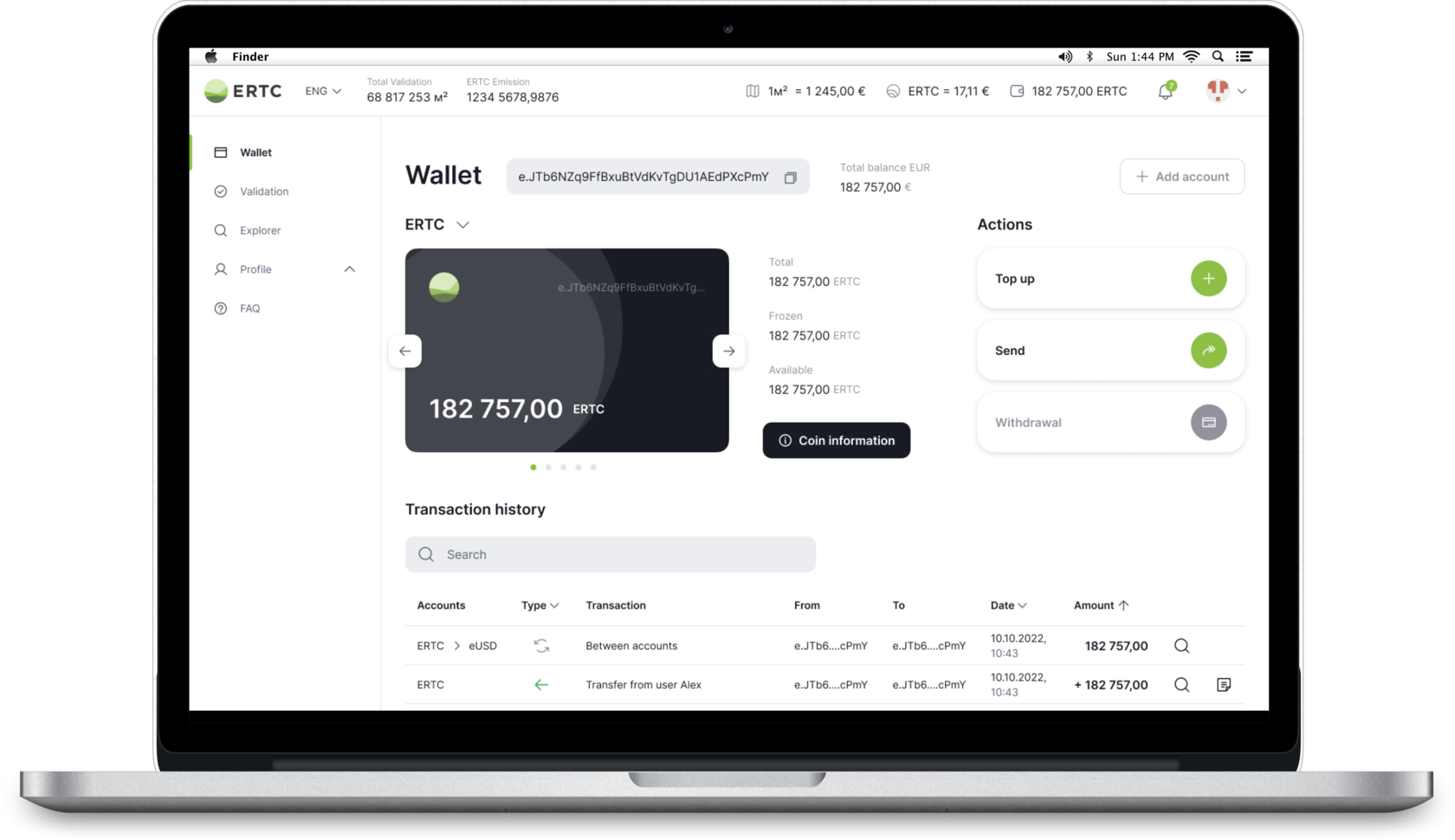
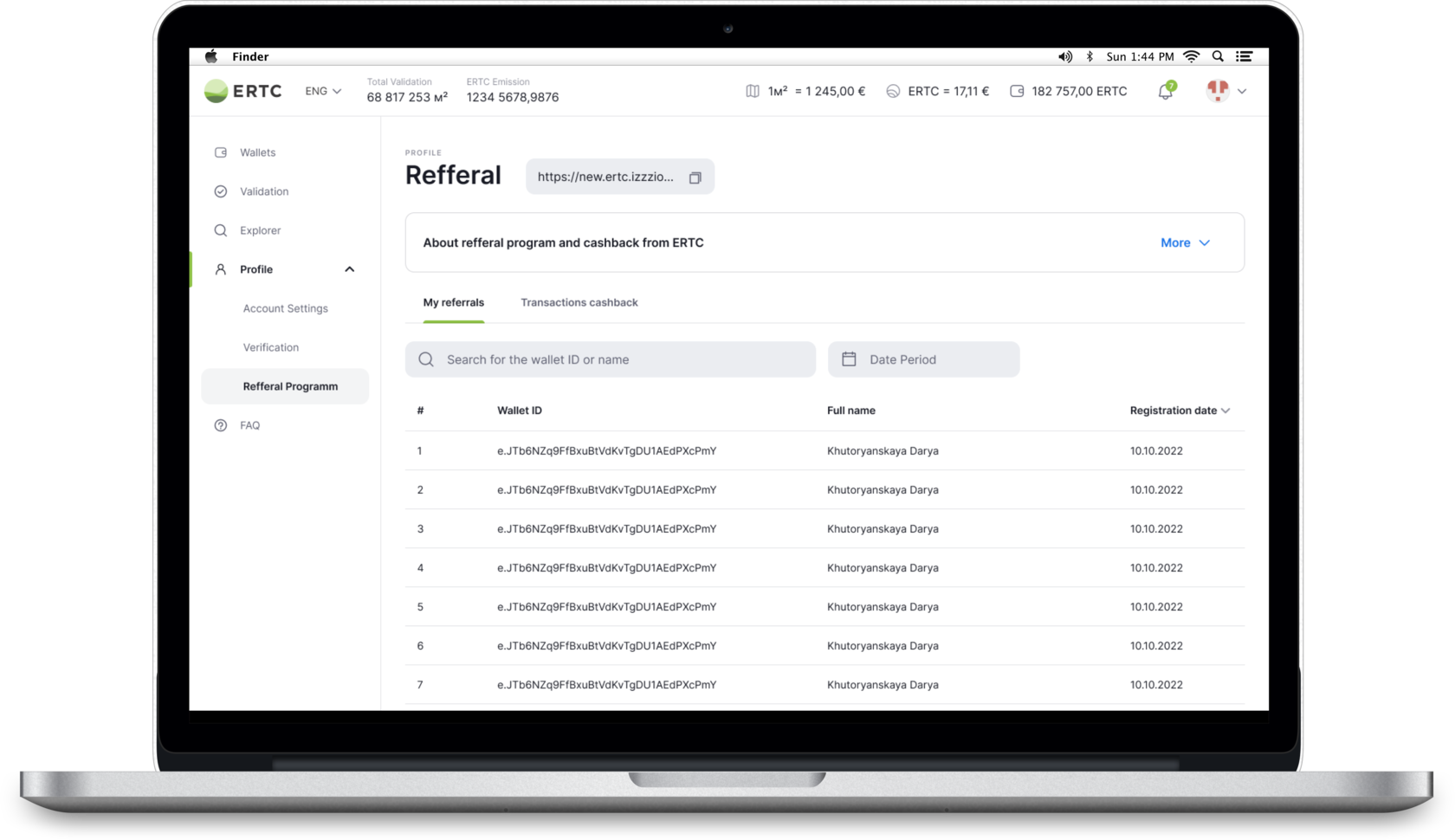
Х ХХХ ХХХ
Х ХХХ ХХХ
ERTC Token Value
1 ERTC = Х.ХХ EUR
Active Nodes
XX
Issue
Usage complexity, price speculation and volatility are the key disadvantages of any cryptocurrency. Market needs stable, understandable and legitimate cryptocurrencies
ERTC Project Suggests
Transforming the traditional fintech market by developing legitimate tools based on virtual currencies and blockchain technologies.
Solution
ERTC – decentralized electronic payment system based on the framework of convenient and technological financial instruments. The main payment unit of which is a Token backed by the land of the planet Earth
The Land — the most valuable resource for humanity and its demand is growing
Advantages
Autonomous blockchain with free native ERTC Token transactions within the network - guarantee reliability and security
Autonomous Blockchain






Unique process of ERTC Token issuance through land property validation
Token issuance through land validation
The Token exchange rate is not volatile - the opportunity to save and increase funds
Stable rate
Simple and available online payments for businesses and individuals
Payment
Compliance with the regulatory requirements of international law and cyber security are the essence of the project concept
System Security
No territorial restrictions and availability 24/7
Platform availability
Benefit from ERTC
Sign up to the platform
Sign up to the platform

Project in digits
as at February 2023


ERTC Framework
decentralized database to record all system events and smart contracts for system processes automatization
ERTC Blockchain
сonsists of functional modules that allow the user to organize validation with the subsequent emission of ERTCoin that is interned in the EPS
Validation Platform

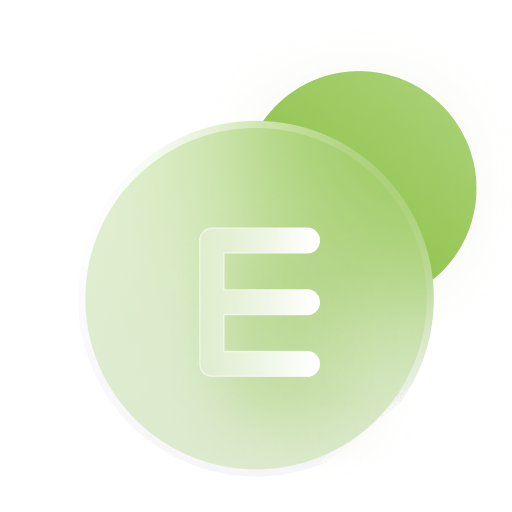
internal digital asset oriented for transactions and actions within the platform. Token Liquidity provided by square meters of the land surface
ERTC Token
electronic payment system based on web3 applications intended for financial transactions within the system
SmartWallet ERTC
ERTC Platform Functionalities
The size of the ERTC Token emission is limited by the land area of the planet and tends to 149,939,063.133 km2
ERTC Token exchange rate is constantly growing and tends to the average cost per square meter of land on the planet (1245 EUR).
ERTC Token rate is calculated by the neural network in hardware according to a predetermined formula with constantly growing input data. (AI)
ERTC Token is issued if the land ownership rights are confirmed.
1m2 = 1 ERTC
Each ERTC Token is an NFT that contains unique information about a square meter of land by the means of which the token was issued:
ERTC transactions are free of charge and are not burdened with commissions
ERTC Token exchange rate is constantly growing and tends to the average cost per square meter of land on the planet (1245 EUR).
ERTC Token rate is calculated by the neural network in hardware according to a predetermined formula with constantly growing input data. (AI)
ERTC Token is issued if the land ownership rights are confirmed.
1m2 = 1 ERTC
Each ERTC Token is an NFT that contains unique information about a square meter of land by the means of which the token was issued:
- Validation date
- Validation number
- Cadastral number
- Longitude/latitude
ERTC transactions are free of charge and are not burdened with commissions
ERTC Token

Learn More
The validation platform is a centralized part of the system, integrated with a blockchain and electronic payment system. It consists of functional modules, allowing to organize the data collection and preparation for recording plots of land in the blockchain validated in the system
Validation occurs in several steps:
Re-validation of previously validated m2 is not possible.
Tokens distribution between the User and System:
Validation occurs in several steps:
- Registration and User Verification in the ERTC System
- Documents submission and land property confirmation, what creates an application for validation
- Validation check by a System Manager
- Emission in the ratio of 1 ERTC Token = 1m2 of validated land
- Data record on the blockchain and ERTC Tokens display in the user's wallet and system bank
Re-validation of previously validated m2 is not possible.
Tokens distribution between the User and System:
- By February 2023: 40/60
- From March 2023: 30/70
Validation Platform
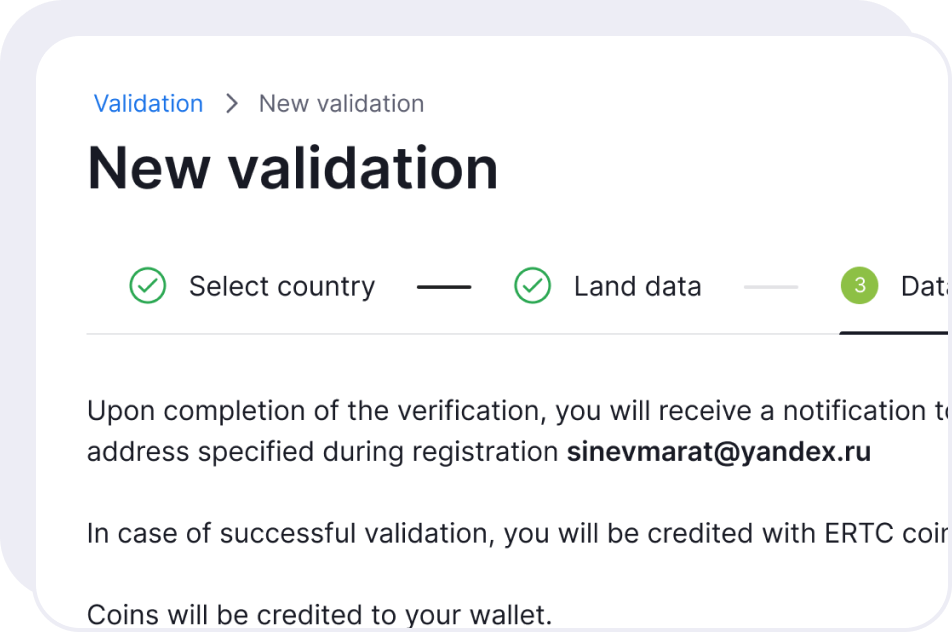
Learn More
The platform module for payments within and outside the system with the lowest fees on the market. All internal payments are free. Platform module for making payments within and out of the system with the lowest commissions on the market, but all internal payments are free.
Electronic Payment System Functions:
Open ERTC API is available for use by online stores and third parties to accept payment for services and goods
Electronic Payment System Functions:
- ERTC Tokens, fiat and other cryptocurrencies storage on a single multi-currency wallet
- Internal and external currency conversion
- Integration with third-party services and acquisition services
- Free cross-border transactions within the payment system.
Open ERTC API is available for use by online stores and third parties to accept payment for services and goods

Electronic Payment System
Learn More
is an open-type blockchain (public blockchain), based on the PoA* (Proof of Authority) consensus algorithm, which implements the function of recording all transactions and events within the system in a decentralized database and automating the system processes through the logic of smart contracts.
consensus mechanism that controls signature keys through nodes administration. Blocks are created and checked by nodes assigned by master nodes.
ERTC Blockchain Function Modules
consensus mechanism that controls signature keys through nodes administration. Blocks are created and checked by nodes assigned by master nodes.
ERTC Blockchain Function Modules
- A master node - privileged server in a decentralized network to conduct instant and anonymous transactions.
- Mobile node - incomplete node connected to full node and used for blockchain access and storage of tracking data
- ERTC Blockchain Explorer allows users to view the contents of the blockchain network, including blocks, wallet addresses, network hash rates, transaction data, and other key system events.
- Smart contracts and DApps with implemented functionality:
ERTC Blockchain

– system internal tokens emission;
– transferring tokens and other currencies between wallets within the platform;
– automation of all system processes;
– tracking the status of all events via blockchain explorer
– transferring tokens and other currencies between wallets within the platform;
– automation of all system processes;
– tracking the status of all events via blockchain explorer
Learn More
Is implemented on the ERTC system basis. Referral Program is a user reward for inviting new users in the amount of 5 ERTC for each user, as well as for transactions in the System.
Referral Program
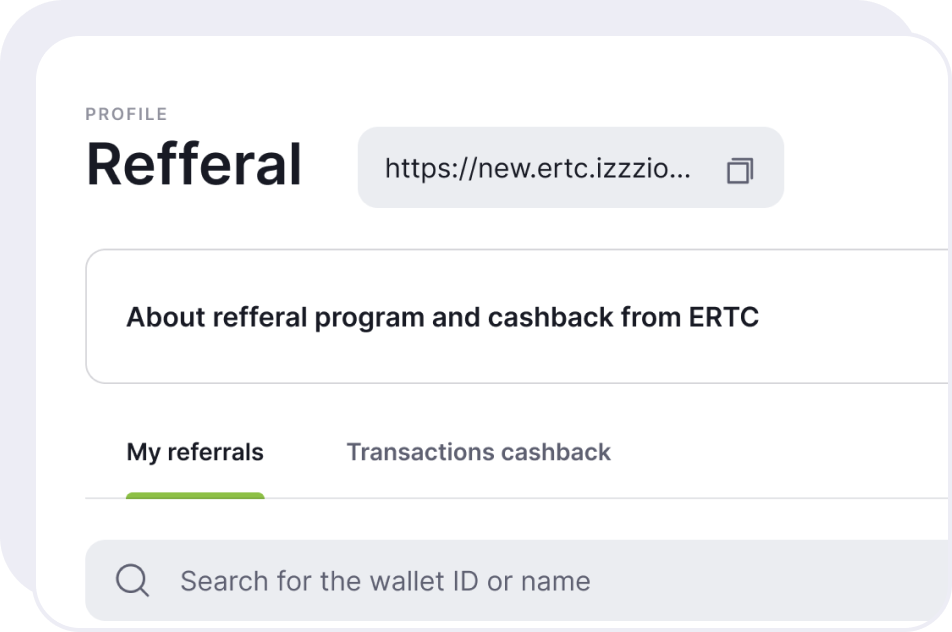
Roadmap

DevOps & Design
Legal Framework
Company development and Market expansion
FAQ
ERTC is an Electronic Payment System with convenient and technologically advanced financial instruments including Electronic Wallet with ERTC token and a variety of currencies. EPS ERTC is based on the ERTC blockchain. ERTC EPS provides for the banking and financial transactions with currencies and ERTC token as well as their harmonious interaction.
- Validation platform – https://ertc.land/
- EPS – https://ertc.land/
- ERTC token repository – https://github.com/Ertconline/smarts
- ERTC blockchain repository – https://github.com/Ertconline/blockchain-ERTC-2.0-Public
- ERTC Explorer – http://explorer.ertc.land/
- Node and Master node – https://ertc.land/download/node/
- Mobile node – https://ertc.land/download/APP/
- Admin Module and Root
You can buy an ERTC Token. Receive a gift from another User by choosing an ERTC Token as a payment. And, of course, validate the land that belongs to You.
Validation is the process of issuing ERTC, in which the owners confirm the ownership of the land in the system, which allows the issuance of ERTC tokens.
Through the ERTC validation-platform, each landowner can validate their plot. For example, if You have 1000 m² of land, You can validate 1000 ERTC tokens. A certain commission goes to the platform for internal operations. After that, 500 ERTC Tokens are credited to Your Smart Wallet. The land remains the property of the owner, re-validation is not possible.
Through the ERTC validation-platform, each landowner can validate their plot. For example, if You have 1000 m² of land, You can validate 1000 ERTC tokens. A certain commission goes to the platform for internal operations. After that, 500 ERTC Tokens are credited to Your Smart Wallet. The land remains the property of the owner, re-validation is not possible.
Yes, You can issue an ERTC token, only by submitting a validation request. The issue of the ERTC Token and the capitalisation of the project are due to the validation of land plots by owners around the world.
Each validated square meter of land is equal to 1 ERTC. The issue is limited.
Each validated square meter of land is equal to 1 ERTC. The issue is limited.
You can validate land in any country in which land ownership is exercised, as long as You provide the required list of documents, which will be verified and confirmed by the ERTC Team
Any fact of fraud/theft/dishonest speculation will inevitably be suppressed so that the Users of the project feel confident and calm about their financial resources. All this is carried out by the decentralised ERTC blockchain, which guarantees the security and reliability of storage and transactions
Absolutely legal. EPS ERTC strives to comply with the law and the requirements of regulators
There are currently no plans for an ICO
The ERTC rate is calculated by artificial intelligence using a mathematical formula and depends on the capitalisation of the project. The amount of validated land, the number of Users and the stage of project implementation. You can find the current rate on the main page
At this stage, the ERTC Token is not a means of payment, but is a digital asset and can be freely converted into currencies inside the wallet of the ERTC platform

Benefit from ERTC
Sign up to the platform
Sign up to the platform




